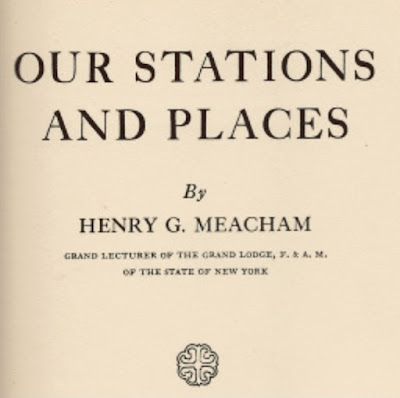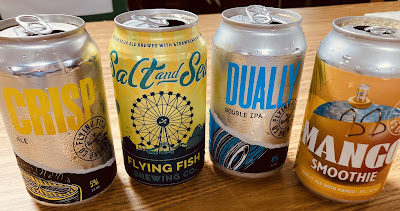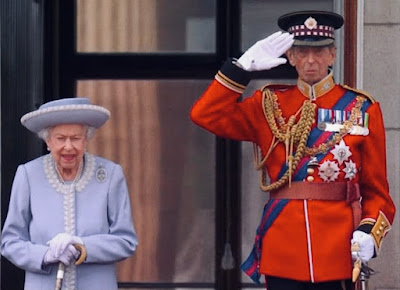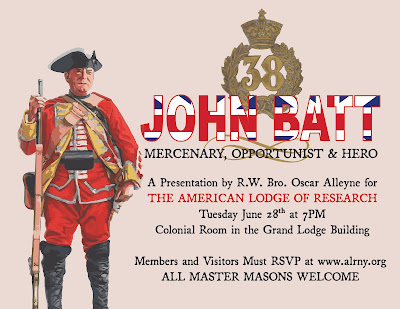Friday, June 17, 2022
‘Rosicrucians: Who and What?’
Thursday, June 16, 2022
‘Our Stations and Places’
Meacham was Grand Lecturer of our Grand Lodge eighty or so years ago, and Grand Lodge published the book.
Wednesday, June 15, 2022
‘Bill Paul Horn Medal 2022’
 |
| Masonic Society President Oscar Alleyne, doing what he does best, at the lectern Monday at the Grand Lodge of Washington’s communication. Cameron Bailey photo. |
Tuesday, June 14, 2022
‘A busy 24 hours!’
 |
| Bro. Barry Holsten of Flying Fish Brewing. |
As you know, the Twenty-Four-Inch Gauge divides a day into equal periods for three essential needs, but did you ever squeeze three Masonic meetings into twenty-four hours?
 |
| Bro. Alex Vastola is at labor in Yorktown-Diamond Thistle Lodge 555 in Tarrytown, New York. |
On a far happier note, New Jersey Lodge of Masonic Research and Education 1786 hosted its quarterly Regular Communication Saturday morning. We welcomed Bro. Alexander Vastola, Director of The Chancellor Robert R. Livingston Masonic Library of the Grand Lodge of New York. He presented a concise description of the institution’s history, goals, resources, and role in Masonic education. The Livingston Library is the envy of most grand lodges in the country, as only a few have exhibited the forethought and commitment to create such a monument to learning. More than 60,000 books and 40,000 artifacts! I’m proud to see The American Lodge of Research, my “other” research lodge, has become a partner with the Library on a few initiatives.
Friday, June 10, 2022
‘Moonlighting for 215 years’
 |
| Warren Lodge 32 |
I know what you’re thinking: “There’s a lodge that doesn’t talk about the electric bill!” It’s just that instead of meeting on specific weeknights, Warren awaits maximum moonlight. Or thereabouts. It was the necessary custom for safe traveling generations ago for lodges to meet when the moon granted the most light. In modern times, they gather on the Thursday before the full moon.
Sunday, June 5, 2022
‘MythBusters: Newport 1658’
If you don’t know what I’m talking about, a rumor was hatched more than a century and a half ago claiming Jewish men from the Netherlands, who settled in Newport, Rhode Island, brought with them Masonic degrees, and set about conferring degrees on others in their community.
It’s nonsense. The circumstantial evidence that exists abundantly, and at your fingertips, convincingly dismisses it. Just because the motto of Rhode Island is “Hope” doesn’t mean we indulge wishful thinking in unpacking history.
 |
| Hope? Anchor? Sound familiar? |
What exactly is this myth?
In 1853, the Rev. Edward Peterson published a book titled History of Rhode Island. I cannot find a copy of this book, but the relevant paragraph has been reproduced in diverse publications of Masonic groups, historical societies, scholars, etc., and those I’ve seen render this paragraph the same way. What I’ll offer here comes from The Jews and Masonry in the United States before 1810 by Samuel Oppenheim, printed in 1910 by the American Jewish Historical Society. Oppenheim (1857-1928) was not a Freemason, but was a renowned lawyer and noted researcher into the history of Jewish people in America from the seventeenth through nineteenth centuries. Excerpted:
In the Spring of 1658, Mordecai Campannall, Moses Peckekoe [Pacheco], Levi, and others, in all fifteen families, arrived at Newport from Holland. They brought with them the three first degrees of Masonry, and worked them in the house of Campannall; and continued to do so, they and their successors, to the year 1742.
This nonsense has been cited as proof that this group introduced what we call Freemasonry to the New World. Alas, there are several red flags frantically waving at us.
Who: Jewish emigres from Holland. I don’t know how it is possible that Jewish Dutchmen possessed the secrets of the Craft. Why not? Well, who exactly were the Freemasons in the Netherlands in the seventeenth century who could have imparted Masonic knowledge to the globe-trotting Campannall? I’ve never heard of Masonic lodges or individual Masons being present in the Netherlands in the seventeenth century. As far as I know, Freemasonry first appeared in the Netherlands at about the same time as it first appeared in America: the early 1730s. And it came to the Netherlands from the same source: the Grand Lodge of England.
 |
| Daniel Coxe by Travis Simpkins |
What: “The three first degrees of Masonry.” Here, the good reverend is making trouble for himself by creating this anachronism. I’ll return to this later.
When: 1658. We know the seventeenth century was the era of the Accepted Mason. Scottish records show that had begun by the 1590s. (Click here.) The building of castles, cathedrals, fortifications, and other stone structures had ceased, and lodges of stone masons began to admit to their ranks men of social (and political, financial, etc.) standing who had no connection to the building arts. Elias Ashmole (1617-92) was neither the first nor the only such Freemason, but he is the best known today, having been initiated by a group of gentlemen Masons on October 16, 1646 that met in the home of one of their number in Warrington, England. That is a historical fact to which we attribute our knowledge of men during the pre-grand lodge era being admitted to lodges despite having no experience in stonework or in architecture. In short, this opportunity to become a Mason was available to men who had clout. Ashmole was a prominent ally of King Charles II, a founding Fellow of the Royal Society, a lawyer, a government official, and the founder of Oxford University’s Ashmolean Museum. It seems to me little is known about the Jewish men from Holland who allegedly brought Freemasonry to the New World, but I don’t see them having power comparable to that of Ashmole’s in basically the same time period.
 |
| Elias Ashmole |
Where: Newport, Rhode Island. Newport? Yes, Newport. What lends a veneer of plausibility to the myth is the documented historical fact that Jews from the Netherlands, or with other connections to that nation, did arrive in Newport in the 1650s. These people were refugees seeking a place to live in safety. They didn’t go to New Netherland (today’s Manhattan) where the Director General, Peter Stuyvesant, made it known that Jews were unwelcome. They had to go elsewhere to find a place where they could live in peace. Long story short: Their ancestors fled Spain and Portugal for their lives; arrived in the Netherlands, which already had a reputation for religious tolerance; and then they traveled to South America and the Caribbean, resulting in our Jewish emigres eventually arriving in Rhode Island, another haven for religious minorities, in the 1650s. It is a documented historical fact that the aforementioned Mordecai Campannall and Moses Pacheco figured centrally in this Jewish settlement in early America. I leave it to you to research that.
Why: The “Why?” always is the most telling factor in an investigation, and I’m sorry to say we’ll never know exactly why Rev. Peterson factored this fictional Masonic angle into his history book. We do know that he cited an early source of his misinformation. Before we content ourselves with the knowledge that Peterson seemingly did not invent the Masonic story, and that he had cited an allegedly existing record proving his Masonic claim outright, let’s look at this primary source.
Peterson said his source was Bro. N.H. Gould, who was Worshipful Master of St. John’s Lodge in Newport, was a member of the Grand Lodge of Rhode Island, and was a Thirty-Third Degree Mason in the Scottish Rite. And here is where the story simultaneously gets interesting and silly. To be fair—and that’s important—we must understand that history, as a field of study, differs greatly today from how it was approached before the twentieth century. Today we expect research that separates the provable from the improbable, but our ancestors beyond recent generations accepted histories bequeathed from the past without a lot of questions. The Bible, the Classics, and other sources—even the Shakespeare folio—comprised the bases of historical knowledge because they had passed the test of time. They were what people knew. Read the history section of James Anderson’s The Constitutions of the Freemasons of 1723 and you’ll see what I mean. It’s ridiculous, but it is exemplary of how people understood history centuries ago.
The Grand Lodge of Massachusetts’ 1870 Proceedings of the Grand Lodge, includes a section on histories of Freemasonry in its and in other states, written by MW William S. Gardner, Grand Master. Under the heading “Masonry in Rhode Island,” he writes:
Br. J.L. Gould, of Connecticut, published, in 1868, at New York, a manual entitled Guide to Chapter, in which this statement is contained:
The earliest account of the introduction of Masonry into the United States is the history of a Lodge organized in Rhode Island A.D. 1658, or fifty-nine years before the revival in England, and seventy-five years before the establishment of the first Lodge in Massachusetts. The author states that ‘The Reverend Edward Peterson, in his History of Rhode Island and Newport in the Past, gives the following account of this early Lodge:
‘In the spring of 1658, Mordecai Campannall, Moses Peckeckon, Levi, and others, in all fifteen families, arrived at Newport from Holland. They brought with them the three first degrees of Masonry, and worked them in the house of Campannall; and continued to do so, they and their successors, to the year 1742.’
This assertion of Br. J.L. Gould, supported by the extract above made from the Rev. Edward Peterson’s History, has attracted attention in England, and has already been examined by the critical pen of W. Br. William James Hughan. Feeling deeply interested in every thing relating to Masonic history in New England, as soon as any attention was called to this claim of antiquity I procured a copy of the Rev. Edward Peterson’s History. On page 101, edition of 1858, appears the above extract in totidem verbis, and, immediately following it, in italics, ‘Taken from documents now in possession of N.H. Gould, Esq.’
(I have no idea if N.H. Gould of Rhode Island, purported source of Rev. Peterson’s misinformation, was related to J.L. Gould of Connecticut, who authored that Guide to Chapter book which planted the myth into the Masonic consciousness.)
Grand Master Gardner’s report continues at length and in detail. Honestly, I’m not willing to transcribe it fully here. Instead, please click here and see Page 357 (an easy-to-remember page number!) to read it entirely. To untwist a complicated story, I’ll summarize in points:
MW Gardiner wrote to Bro. N.H. Gould and others in Rhode Island in search of the conclusive origin of the story of Jewish immigrants bringing Freemasonry to Newport in 1658. It took nearly a year for Gould to write back, but he described how he and Rev. Peterson “studied out” an originative document behind this claim.
This document, said Bro. Gould, had been among the possessions of the late Hannah Hall, “a distant relative” of Gould and the great, great, granddaughter of John Wanton, who had been governor of the Rhode Island colony from 1734 to 1740. The paper was among a trove of letters and such found inside a dilapidated trunk. Due to the age and the poor storage of the paper in question, it was damaged and illegible in places, but its text allegedly read:
Ths ye [day and month obliterated] 1656 or 8 [not certain which, as the place was stained and broken; the three first figures were plain] Wee mett att y House off Mordecai Campanall and affter Synagog Wee gave Abm Moses the degrees of Maconrie.
And here, again, is Rev. Peterson’s take:
In the Spring of 1658, Mordecai Campannall, Moses Peckekoe [Pacheco], Levi, and others, in all fifteen families, arrived at Newport from Holland. They brought with them the three first degrees of Masonry, and worked them in the house of Campannall; and continued to do so, they and their successors, to the year 1742.
So now you are wondering where Peterson found the “three first degrees” detail, as well as the mention of 1742. I think that he, armed with some knowledge of the Freemasonry of his own time, simply added those details, assuming they could be backdated. We know there weren’t three or more degrees in Masonry in the seventeenth century. The specific talk of 1742 is vexing. I cannot find anything that might fit that reference. The aforementioned St. John’s Lodge, the first in the colony, dates to St. John Evangelist Day 1749.
Gould goes on to explain:
By the foregoing you will see that the document spoken of by the Rev. Edward Peterson was in a very tender state: broken and as brittle as those very old papers, exposed as it had been exposed, to alternate wet and heat. After a time it became so broken that I could not have it even daguerreotyped, as, at that time, photography was not practiced in our city, but what there is of it was nicely enveloped and packed away, with some of my papers in my house, securely, but not where I can, at present, put my hand upon it, but hope, with God’s blessing, to be able to again get my library together in their cases, and many papers assorted, when it will be, or what may be left of it, visible.
I say what we have here is, simply, a canard. This alleged source document that puts Masonic activity in Newport, Rhode Island in 1658 not only cannot be scrutinized by us—even in some facsimile—but it doesn’t appear to have been seen by anyone contemporaneous who possibly could avouch it. In our twenty-first century expectations of historical analysis, this fails any reasonable standard. That is mostly why I call the myth nonsense, but there’s more, which I’ll come to.
Writing in his History of Freemasonry in Rhode Island, published 1895 for the 1891 centenary of the Grand Lodge of Rhode Island, Grand Historian Henry W. Rugg opines: “Evidently no great reliance could be given to such a scrap of paper even were its genuineness assured. It lacks the support of corroborative evidence.” (I think Rugg puts it so politely because he was a Doctor of Divinity.)
Massachusetts Grand Master Gardner also had written to Rhode Island Grand Master Thomas Doyle, who replied:
As to the statement, in Peterson’s History of Rhode Island, that Masonry was worked in this State from 1658 to 1742, I can only say that, from the best information I can obtain in regard to that history, the statement is not to be taken as a fact, unless supported by other reliable testimony. What he has said about Masonry is, I understand, asserted upon the authority of documents in the possession of W. Br. N.H. Gould. I have made many enquiries about these documents of brethren in Newport, members of the Grand Lodge and others, and do not find that any one has even seen them, neither do the brethren believe that any proof exists of the truth of Peterson’s statement.
So why didn’t I just make that point from the start and spare you all this reading? Because I get paid by the word. Seriously though, if you’ve read this far then maybe you’ll agree that it is important to respect history by not co-mingling untruth and distortion with facts.
Those further complications I mentioned:
If you have made a study of what we know of seventeenth century and other pre-grand lodge era manuscripts, then you know how oaths of that time concluded with avowals to Jesus Christ. Masonry, as it existed then, was a Christian society. Anyone believing in this myth would have reconcile that, at the very least. The record of the first Jewish man to be made a Freemason places it in London during the 1720s. I regret not having the specifics of that to add here, but think Anderson’s First Charge.
In addition, there is the philology of it. I do not believe that a Sephardic Jew from the Netherlands would jot a note to self (or to someone else in his community) employing some kind of pre-Elizabethan English. “Wee mett att y House off Mordecai Campanall and affter Synagog Wee gave Abm Moses the degrees of Maconrie.” Maybe it could have worked out that way, but I don’t see it being likely. Being from the Netherlands, one might write in Dutch. Being Sephardic, one might write in Ladino. Being in 1658, one might be illiterate. In fairness, our Mr. Samuel Oppenheim, of the American Jewish Historical Society, disagrees. He says:
The period of composition of the document may be practically determined, independently of the date given in it, from the style of its orthography. In the doubling and raising of letters, in the unusual forms ‘Maconrie’ and ‘off’ for ‘of,’ and even in the apparently inconsistent variation in the manner of spelling ‘off’ and ‘ye’ in a single writing, the orthography is peculiarly of the seventeenth century and not of a later period and is thus confirmatory of genuineness. Its language and style of composition indicate a Jewish hand as the author.
Oppenheim strikes me as an impressive and serious man, but what he says here is very highly speculative, and I do not know what knowledge and experience he possessed in linguistics. And how does one assess an unknown writer’s religious views from a brief note?
And, returning to “the three first degrees of Masonry,” it is basic Introduction to Masonic History 101 that the Third Degree emerged during the 1720s. No one knows exactly when, or written by whom, but it emerged in London when the Grand Lodge began to take the shape we know today. Earlier records show a two-degree system of primitive rituals. Saying there were three degrees in 1658, and that they were the first three—implying there were others—is nonsense. For a look at what Masonic degrees looked like circa 1730, see the ritual exposure Masonry Dissected. The Masonic Book Club will reprint it this summer.
If you enjoy Masonic history, and think you’d want to examine and write about some aspect, it is important to research and not be content with one unattached statement found on a webpage. It’s never been easier than today to undertake a little inquiry, thanks to the multitude of online resources. For the more motivated researcher, visits to libraries, museums, historical sites, historical societies, the occasional cemetery, and other destinations are necessary, but without leaving my chair I was able to present this humble edition of The Magpie Mason. My thanks to Bro. Jerry for the inspiration.
Jewish Freemasons have much for which to be thankful and in which to feel pride, even in the specific context of Newport: There is the obscure, but real, history of King David’s Lodge which settled there after removing from New York in the eighteenth century. And also, of course, the visit of President George Washington to the town, during which he engaged both the local synagogue and the Masonic lodge in correspondence. (Read about that here.) There is no need to diminish real history by mixing in unsubstantiated and illogical tales.
Saturday, June 4, 2022
‘Masonic Con Manchester (Part I)’
 |
| Absolutely perfect weather greeted us at Masonic Con 2022 in Manchester, New Hampshire. |
Masonic Con 2022 New Hampshire is in the books. An amazing conference uniting Freemasons from many states and other countries that all of us will remember for many years.
Friday, June 3, 2022
‘House of the Temple vandalized’
Two years to the day after the House of the Temple was spray painted with graffiti during days of violence around Washington, DC, the two sphinxes outside the landmark were just damaged in another attack, according to Arturo de Hoyos, who shared the news via social media this afternoon.
Master sculptor Adolph Weinman created the pieces on site. He also is known for his work with the U.S. Mint, having designed both the Mercury dime and the Walking Liberty half dollar, Art also said.
‘Keystone State dates’
Thursday, June 2, 2022
‘Grand Master on the balcony’
The Grand Master of the United Grand Lodge of England took his rightful place on the palace balcony alongside Queen Elizabeth II this morning following the Trooping the Colour portion of the Platinum Jubilee celebration. Prince Edward, the Duke of Kent, is a cousin of the Queen.
‘Oscar at The ALR’
RW Bro. Oscar Alleyne will be our presenter at The American Lodge of Research’s meeting this month. Sometimes you need star power.
Wednesday, June 1, 2022
‘Vastola to visit research lodge’
Bro. Alex Vastola, Director of The Chancellor Robert R. Livingston Masonic Library of the Grand Lodge of New York, will be among the speakers next Saturday, bringing us up to date on the institution’s programs and other essential work.
Friday, May 27, 2022
‘Our established mode of government’
Thursday, May 26, 2022
‘Explore gastronomical Gettysburg’
 |
| I’ll go ahead and guarantee you’ll be more enthusiastic about the meal than this. |
For the 159th anniversary of the decisive day of the Battle of Gettysburg, the local Masonic lodge invites you to a historical re-enactment dinner.
Wednesday, May 25, 2022
‘Bricks for Fredericksburg’
Speaking of brick (see post below), Fredericksburg Lodge 4 could use your help. The legendary lodge in Virginia that made Masons out of George Washington and other notables seeks to raise money for the maintenance of its building. It is 206 years old and has been in Masonic use the whole time.
















































































